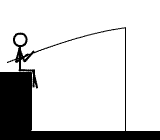Rain Syndrome ulit :)
Haaayyy late na naman ako...napakatrapik!!! Bkit kaya ganun? Pag umuulan trapik. Dahil kaya walang, Traffic Enforcers? O kaya dahil maraming ng bababad na jeep to accomodate the passengers na walang payong at nasa silong na? Pg nakamotor lahat kaya ng Tao, me trapik kaya? Panu nman kaya sila bibiyahe kung motor, e walng bubong un? Ewan ko bahala na:)
_________________________________________________
A Practical Guide to Musical Composition
by Alan Belkin, 1995-1999
PART 0001
Stylistic Assumptions
A legitimate question here is to what extent principles of "musical form" can be generalized across
different styles. This question is especially pointed today: since non-western and popular musics
are so much more familiar to many listeners, it can be argued that a beginning composer today
no longer starts with a clear attachment to one pervasive tradition.
It is difficult to teach composition without making at least some assumptions about formal
requirements; otherwise, what is there to teach? The crux of my argument here is that basic
principles of the type enumerated above result largely from the nature of musical hearing. Let us
make clear some of the assumptions subsumed by the phrase "the nature of musical hearing".
We assume first that the composer is writing music meant to be listened to for its own sake, and
not as accompaniment to something else. This requires at a minimum provoking and sustaining
the listener's interest in a musical journey across a range of time, as well as managing to bring
the experience to a satisfactory conclusion. Thus, "musical hearing" implies here a sympathetic
and attentive listener, at least some of whose psychological processes in listening to the work can
be meaningfully discussed in general terms.
We will limit our discussion to western concert music. Non-western musics, which often imply
very different cultural expectations about the role of music in society or its effect on the
individual are thus excluded from our discussion. (2)
Further, although some of the notions presented here may also apply to "functional music" (e.g.
music for religious services, ceremonial occasions, commercials) all these situations impose
significant external constraints on the form. Specifically, the composer's formal decisions do not
derive primarily from the needs of the material. In concert music, by contrast, the composer is
exploring and elaborating the chosen material in such a way as to satisfy an attentive musical ear.
If extramusical limitations apply - like having to reach a climax 23 seconds into a commercial, or
to stop when the priest reaches a given point in the service - the composer cannot give his ideas
their head. We will therefore also exclude functional music as an object of direct discussion. (3)
Our discussion will not be limited to "tonal music". I have made considerable effort to present
these ideas in ways that do not depend on a tonal harmonic language. Indeed, some of these
notions become especially useful when the familiar harmonic conventions which contribute to
the listener's sense of formal orientation in tonal music are not available.
---->>
1. Musical Form- best example is a sentence, it has a subject and a predicate. Or, in other explanation, it's just like weaving a basket or forming a pot, which encorporates interconnection of the different parts to have a good piece,if not a masterpiece. One kind type of a musical form is A-B-A(verse-chorus-verse).
2. Functional Music- it is self-explanatory. Music for functions. We had a subject in the College of Music, University of Santo Tomas Philippines, which is Functional Music.Not only we did the music for such functions as above, we had composed also incidental music for plays...cool!
3. impose significant.... - of course, this will limit the creativity of the composer, that's why the author of this book will not concentrate on functional music.
4. Tonal Music- A music with a tonal center.It revolves around a Key.
Atonal Music- A Music without a tonal center. It revolves anywhere the 12 notes of an octave even without a resolution. This music is usually explained by advanced mathematics,Mode 12.
______________________________________________________
A Site with Extreme Quality of Music and all usage of it(From Mobile to Film to Ringtone to Score.Where the author, musicians and other artists share their craft...:D
______________________________________________________




0 Comments:
Post a Comment
<< Home